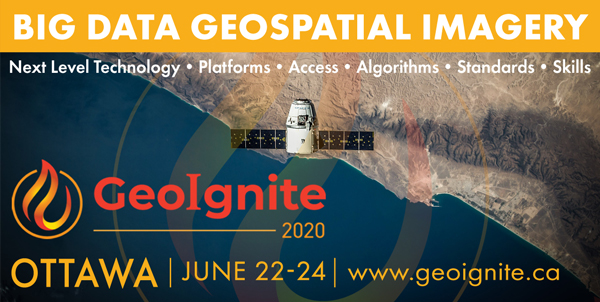Big Data Geospatial Imagery – Next Level Technology, Platforms, Access, Algorithms, Standards & Skills

Track Chair: James Ashton and John Roos
“Everyone agrees with the zero download model. No downloads. We hope that the space agencies will open up the data, produce analysis ready data, that will be put on cloud platforms, we are going to have software on these platforms, we are going to get the results, users will all be empowered, we are going gain a better understanding for sustainable development”

Big Data Geospatial Imagery
Future of innovations in remote sensing, geomatics and imagery will depend on translating big data into information and knowledge. Navigating new cloud based platforms and cloud native processes are required to conduct predictive analytics and monitoring of occurrences on the land. Canada has many active scientists working on the phonological aspects of disease, harvest detection, drought, flood, soil moisture, detection, emergency response. However, there is considerably less investment in aspects navigating an agile cloud implementations that scale to the cloud and harmonizes these data science activities in the public cloud offering.
Computational power, the increased availability of high resolution remote sensing data, and existing Canadian data products openly distributed can be leveraged as building blocks for creating detailed, national-scale occurrence and monitoring maps. Synthetic Aperture Radar (SAR) and existing raster and vector dataset composites can be used and combined into analytical algorithms to identify the spatial distribution of disturbance across many sectors.
Much of this Canada’s imagery data has been underutilized and never subjected to deep learning and neural networks to date. Traditionally collecting, storing, processing, and manipulating multi-temporal remote sensing data that covered a large geographic area over decades are infeasible using conventional software on workstation PC-based systems. As with all technologies projects the human element is as important than any other aspect of the project. Digital transitions demands training, experimentation with technologies and processes with the computational capacity and architectures for handling such a large volumes of geospatial information in the cloud. From a data science perspective, this transition requires new approaches beyond just software and success will be deeply rooted in getting to the operational cloud environments or purchasing commercial services that will enable truly transformative geospatial imagery data, standards, and analytical pipelines.
The transition from geospatial imagery to valued information and adaptations will not be made by investing in one single project or operational system. Transition of cloud savvy organizations and a vibrant geospatial economy using AI and Big data will be made by a series of initiatives that embrace rapid, exploratory, and iterative innovation rather than embracing the risk-averse, politicized culture that demands perfection at the outset.
THANK YOU TO OUR GOLD AND SILVER SPONSORS






